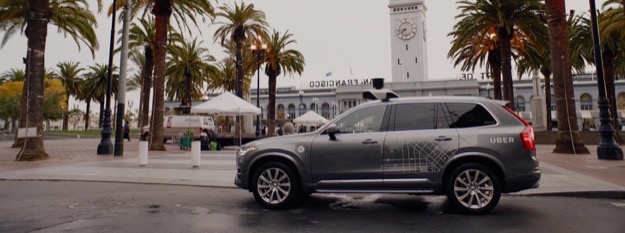
Uber and the California department of motor vehicles appear headed to court in a dispute that could add some needed clarity to the state’s position regarding regulation of self-driving cars. On Friday, the head of Uber self-driving car team, Anthony Levandowski, said that they didn’t need the DMV’s permission to run their vehicle on San Francisco streets because it wasn’t really autonomous…
From a technology perspective, self-driving Ubers operate in the same way as vehicles equipped with advanced driver assist technologies, for example Tesla auto-pilot and other OEM’s traffic jam assist. This type of technology is commonplace on thousands of cars driving in the Bay Area today, without any DMV permit at all. That is because California law expressly excludes from its law vehicles that have “collision avoidance” or “other similar systems that enhance safety or provide driver assistance” and, like our self-driving cars, are “not capable, collectively or singularly, of driving the vehicle without the active control or monitoring of a human operator.”
That brought a sharp reply from the California attorney general’s office…
We, as attorneys for the Department of Motor Vehicles, by this letter, are asking Uber to adhere to California law and immediately remove its “self-driving” vehicles from the state’s roadways until Uber complies with all applicable statutes and regulations. If Uber cannot advise the undersigned that it will immediately remove its self-driving vehicles from California public roadways until it obtains the appropriate permit, as 20 other companies have done, the Attorney General will seek injunctive and other appropriate relief.
More than any other state, California has jumped into the legal and regulatory void that initially surrounded self-driving cars, even rubbing up against federal regulators who want to carve out their own, exclusive authority. In many ways, that’s been good – at the least, California’s nascent rules create a safe harbor of sorts for companies that are developing the technology.
But that early advantage can quickly turn into a disincentive, as other states follow behind and adopt a more entrepreneurial approach to self-driving cars and other advanced transportation technologies. Uber’s rapid rise to the top of the ride sharing market was the result of a willingness – almost a compulsion at times – to challenge laws and regulations that served the interests of taxi companies. Uber has been largely successful in that regard, to the great benefit of the public.
At the least, by challenging the DMV, Uber could force the state to draw a sharper line around what it does and doesn’t regulate. Where that line falls is important – a tight circle would encourage autonomous car and other advanced technology development here, expansive limits could drive innovators to Texas. Either way, at least we’ll know.
